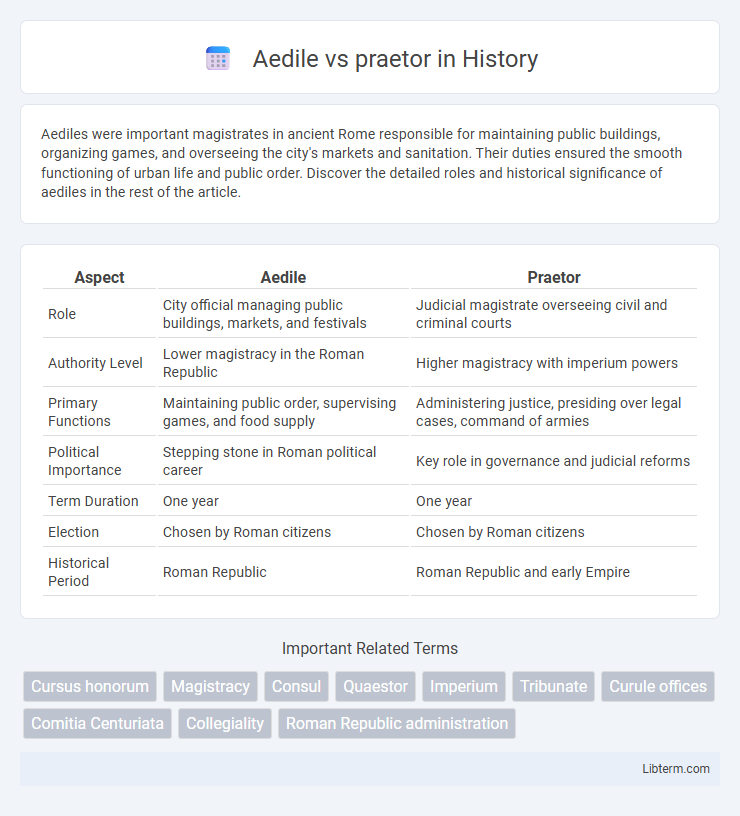Aediles were important magistrates in ancient Rome responsible for maintaining public buildings, organizing games, and overseeing the city's markets and sanitation. Their duties ensured the smooth functioning of urban life and public order. Discover the detailed roles and historical significance of aediles in the rest of the article.
Table of Comparison
| Aspect | Aedile | Praetor |
|---|---|---|
| Role | City official managing public buildings, markets, and festivals | Judicial magistrate overseeing civil and criminal courts |
| Authority Level | Lower magistracy in the Roman Republic | Higher magistracy with imperium powers |
| Primary Functions | Maintaining public order, supervising games, and food supply | Administering justice, presiding over legal cases, command of armies |
| Political Importance | Stepping stone in Roman political career | Key role in governance and judicial reforms |
| Term Duration | One year | One year |
| Election | Chosen by Roman citizens | Chosen by Roman citizens |
| Historical Period | Roman Republic | Roman Republic and early Empire |
Introduction to Aedile and Praetor
Aediles were Roman magistrates responsible for overseeing public buildings, games, and the grain supply, ensuring urban order and infrastructure maintenance. Praetors primarily served as judicial officials, managing civil law courts and governing provinces, with authority extending over legal and administrative matters. Both positions played crucial roles in the Roman Republic's political and social framework, balancing public service with legal administration.
Historical Origins and Background
The aedile and praetor were key magistracies in the Roman Republic with distinct historical origins and functions. Aediles, established in the 5th century BCE, primarily oversaw public buildings, markets, and festivals, reflecting Rome's urban development needs. Praetors, originating around 367 BCE, held judicial authority and imperium, acting as judges and military commanders, demonstrating the Republic's evolving legal and administrative complexity.
Roles and Responsibilities Compared
Aediles were primarily responsible for the maintenance of public buildings, regulation of markets, and organization of public games, ensuring urban order and citizen welfare in ancient Rome. Praetors held judicial authority, overseeing civil and criminal courts, and acted as governors in provinces, wielding significant administrative and military power. While aediles focused on city management and public services, praetors played a crucial role in legal administration and provincial governance.
Political Significance in Roman Society
Aediles in Roman society managed public services, urban maintenance, and organized games, playing a crucial role in maintaining civic order and public morale, which bolstered their political influence at the local level. Praetors held judicial authority and imperium, overseeing courts and provincial governance, which positioned them as key figures in the administration of Roman law and expansion of Roman control. The political significance of aediles lay largely in their visibility and relationship with the populace, while praetors combined legal expertise with military command, making them essential for Roman political hierarchy and career advancement.
Qualifications and Election Process
Aediles were typically young Roman politicians who had to be at least 36 years old and of plebeian status, serving as an entry-level magistracy focused on urban management and public games, elected by the Tribal Assembly. Praetors required a minimum age of 40 and often had prior experience as aediles or quaestors, with responsibilities centered on judicial authority and governance, elected by the Centuriate Assembly. Both offices demanded Roman citizenship and a trajectory through the cursus honorum, but the praetorship held higher prestige and judicial power compared to the aedileship.
Jurisdiction and Legal Authority
The Aedile's jurisdiction primarily encompassed the maintenance of public buildings, regulation of markets, and oversight of urban affairs in Rome, with limited legal authority mostly related to public order and commercial regulations. Praetors held broader judicial powers, including presiding over civil courts and interpreting Roman law, often serving as chief magistrates responsible for administering justice and issuing edicts that shaped legal precedents. While Aediles enforced specific regulations within the city, Praetors exercised expansive legal authority across the Roman state, managing both civil and criminal cases with significant influence on the legal system.
Public Works and Urban Management
Aediles were primarily responsible for maintaining public buildings, overseeing markets, and managing urban infrastructure such as roads, aqueducts, and public festivals, ensuring the smooth operation of daily city life in ancient Rome. Praetors held broader judicial powers but also supervised certain aspects of urban management, including the administration of justice related to public order and the regulation of municipal affairs. While Aediles concentrated on the practical upkeep and regulation of urban public services, Praetors played a key role in legal oversight and the enforcement of laws impacting city governance.
Aedile vs Praetor: Key Differences
Aediles primarily managed urban maintenance, public games, and market regulation in ancient Rome, while praetors held judicial authority and commanded armies. The aedile's role was more administrative and civic-focused, overseeing infrastructure and public order, whereas praetors were important magistrates responsible for law enforcement and governance in both Rome and provincial territories. Aediles were lower-ranked officials assisting consuls, while praetors ranked just below consuls with broader powers including presiding over courts and provincial administration.
Influence on Roman Governance
Aediles and praetors held distinct roles influencing Roman governance, with aediles managing urban infrastructure, public games, and market regulations, thereby ensuring civic order and social cohesion. Praetors exercised judicial authority, overseeing legal matters and administration of justice, which shaped the Roman legal system and reinforced imperial governance. The interplay between these offices facilitated effective urban management and legal order, crucial for maintaining the Republic's political stability.
Legacy and Long-Term Impact
Aediles significantly influenced urban management and public services in ancient Rome, laying foundational structures for civic administration still referenced in modern municipal governance. Praetors established enduring legal frameworks, particularly in civil law and judicial procedures, shaping the development of Western legal systems. Their combined legacy fostered the integration of administrative efficiency and juridical authority, impacting both Roman societal order and contemporary institutional design.
Aedile Infographic

 libterm.com
libterm.com